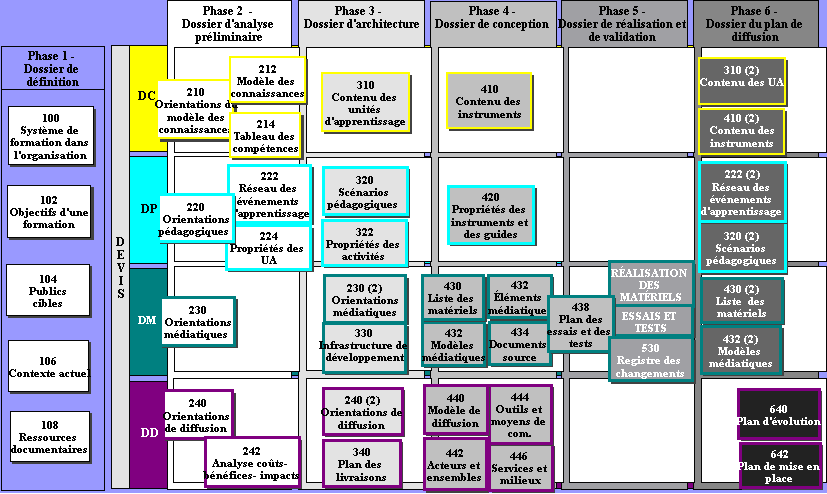MISA: Difference between revisions
Jump to navigation
Jump to search
m (→References) |
|||
| (8 intermediate revisions by 2 users not shown) | |||
| Line 1: | Line 1: | ||
== Definition == | == Definition == | ||
MISA | * MISA is an instructional engineering method describing graphically the instructional design processes and their products which define a learning system completely. MISA supports 35 main tasks or processes and around 150 subtasks. The method has been totally represented within the MOT knowledge editor. [http://www.licef.teluq.uquebec.ca/gp/eng/productions/misa.htm] | ||
* MISA = Méthode d'Ingéniérie cognitive de Systèmes de Téléapprentissage | |||
== MISA Components == | == MISA Components == | ||
MISA | The MISA method identifies four axis | ||
# DC: Design of Content (know-that and know-how) | # DC: Design of Content (know-that and know-how) | ||
#* Knowledge and Skill Representation | #* Knowledge and Skill Representation | ||
# DP: Design of Pedagogical specifications | # DP: Design of Pedagogical specifications | ||
#* Application of Teaching Methods and Approaches | #* Application of Teaching Methods and Approaches | ||
# DM: Design of Materials | # DM: Design of Materials | ||
#* Specification of Learning Materials | #* Specification of Learning Materials | ||
# DD: Design of Delivery | # DD: Design of Delivery | ||
#* Delivery Planning | #* Delivery Planning | ||
There are 6 phases: | |||
# Definition of the project (dossier) | |||
# Preliminary analysis | |||
# Definition of the course architecture | |||
# Design of the various elements | |||
# Implementation and validation | |||
# Diffusion (field implementation) | |||
Roughly, a timeline for development could look like this: | Roughly, a timeline for development could look like this: | ||
| Line 20: | Line 30: | ||
[[Image:MISA-Timeline.png]] | [[Image:MISA-Timeline.png]] | ||
The 4 components | The 4 components split over the 6 phases lead to the 35 main tasks: | ||
[[Image:MISA_Overview_fr. | [[Image:MISA_Overview_fr.png]] | ||
== Software == | == Software == | ||
MISA MOT Software is free for non-profit organizations we believe) that can be obtained from [http://www.cogigraph.com Cognigraph]. | |||
MOT is a | * MOT is a specialized concept map editor | ||
* [[MOTPlus]] includes support for [[IMS Learning Design]] | |||
== Links == | == Links == | ||
| Line 32: | Line 44: | ||
== References == | == References == | ||
* Gilbert Paquette, Instructional Engineering in Networked Environments, Wiley, ISBN 0-7879-6466-2 | |||
* (Todo: Add the 2 french books) | |||
[[Category:Design methodologies]] | [[Category:Design methodologies]] | ||
[[Category:Instructional design methods]] | |||
[[Category: Educational modeling languages]] | |||
Latest revision as of 18:27, 28 May 2007
Definition
- MISA is an instructional engineering method describing graphically the instructional design processes and their products which define a learning system completely. MISA supports 35 main tasks or processes and around 150 subtasks. The method has been totally represented within the MOT knowledge editor. [1]
- MISA = Méthode d'Ingéniérie cognitive de Systèmes de Téléapprentissage
MISA Components
The MISA method identifies four axis
- DC: Design of Content (know-that and know-how)
- Knowledge and Skill Representation
- DP: Design of Pedagogical specifications
- Application of Teaching Methods and Approaches
- DM: Design of Materials
- Specification of Learning Materials
- DD: Design of Delivery
- Delivery Planning
There are 6 phases:
- Definition of the project (dossier)
- Preliminary analysis
- Definition of the course architecture
- Design of the various elements
- Implementation and validation
- Diffusion (field implementation)
Roughly, a timeline for development could look like this:
The 4 components split over the 6 phases lead to the 35 main tasks:
Software
MISA MOT Software is free for non-profit organizations we believe) that can be obtained from Cognigraph.
- MOT is a specialized concept map editor
- MOTPlus includes support for IMS Learning Design
Links
References
- Gilbert Paquette, Instructional Engineering in Networked Environments, Wiley, ISBN 0-7879-6466-2
- (Todo: Add the 2 french books)

